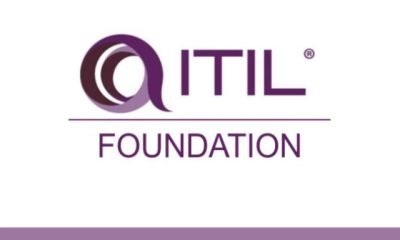Business
Customer Success: The Definitive Guide in 2020


One of the most widely known concept, yet comparatively unknown and inexperienced to most marketers and organizations. According to a Digital Adoption Report, it is estimated that “More than 60% of organizations realized customer success as a formalized field in the last two years, until then relying on third-party consultants and experts to define their business strategies”.
Customer Success or often referred to as “Customer Buy Success” is a proactive art of creating a seamless experience for customers to achieve their potential desired outcome or reactive support through business interactions by making the entire customer journey objective and resolution-led.
Bain & Company defines – “Customer Success initiatives when collaborated with key management principles can lead to an increase in profits of a company by 95%”.
Difference Between Customer Success And Customer Service
To understand the difference between these two terminologies, we’ve to understand what customer success used to mean earlier and how it got transformed into the next version 2.0.
Version 1.0
Earlier customer success focused on mitigating the management related risks and improving the customer’s overall journey.
Version 2.0
However, the updated version of customer success recognizes customer experience and success as and beyond a growth engine where customer needs and value may vary according to businesses. Thus, adopting a more comprehensive, cross-functional approach that is customer-focused and aligned to improve the customer’s overall journey and retaining the customer simultaneously.
Mission & Objective – The vital difference between the two terms based on mission and objective are:
Customer success is concentrated on investing within the long-term, building the lifetime value of consumers through consistent support and investing in their business as if it were their own.
On the opposite hand, customer service focuses on winning the one-time transaction. Helping a customer in need who has issues with their account, the software, or any function that involves your business.
“Your customer makes their own success. By accepting that, you put the customer first.”
— Brian Gladstein
Approach – Customer success is concentrated more on empowering customers to succeed together with your product or service within the future, instead of solving issues within the short term.
Meanwhile, Customer service is your second acquisition test behind actually acquiring that customer within the first place, making it an important role within the success of any given customer or company.
Focus Areas & Metrics – In essence, customer success teams are focused on helping customers achieve greater value and are genuinely seeking to enhance their business. Success teams specialise in preventing conflict from happening, giving customers the facility to enhance their business, and developing systems that help customers to seek out continual success.
Whereas, Customer Service or Support roles generally fall into conflict resolution, responding to tickets, answering phone calls from struggling customers, and responding to all or any customer concerns.
Customer Service can be regarded as the baby steps to help in the overall customer success journey. Without customer service, customer success is null and void. If you’re a new customer buying a product from a company, you’ll likely need or expect the after-sales support or services in one way or another.
Why Customer Success Is Important?
The first interaction with customer support or service is going to be critical in determining their propensity to continue doing business with you.
In a study published in 2010, it was calculated that – “82% of consumers would bail on a corporation after one negative experience with customer service.”
While “51% of consumers will never return to a corporation after having a bad experience in customer service.”
Not only will one bad experience cause people to leap ship and test other brands, products, and services, but it often also seals your fate: losing the customer permanently.
“Until you know what it takes to achieve success from your customers’ perspective you will just waste valuable time.”
— Jason Whitehead
Customer Success is crucial to any business as bad customer service will have a reach twice as huge as a good experience, but it will take 6 times your good and positive experiences to make up for that bad one.
Customer Success is not only about the communication strategies but also the business processes you induce to keep proving your business value to your customers.
As it is often said, it can either “make your business or break your business.”
How Do You Succeed in Customer Success?
There are various ways or elements that businesses opt to succeed in Customer Success ranging from developing a solution-based platforms to team building models to improve the customer’s overall journey and experience.
Here are some of the points that you can implement to succeed in Customer Success:
1. Solution Focused Approach – In order to manage all your communications and interactions with your customers and business clients, you’ll need to build and implement a solution-focused customer success approach for your team to communicate all business interactions with existing or potential clients. These solutions can be anything ranging from software or tools required to connect to your customers in real-time and ensuring fast response, resolution, and success is derived to keep your customers happy.
2. Team-Building Approach – To manage all your business interactions, you’ll also require a team or group of people having knowledge with the customer success field to assist the existing customer base and potential new customers. The number of employees you hire will largely depend upon the size of the organization you have and how many customers you serve daily. Team building approach will not only drive your business to profits but also ensure customer experience, success, and service all at one time.
3. Formulating Strategies – One of the crucial most factors in deriving customer success is how as a business you formulate or bring about the strategies to build a larger customer base and simultaneously ensuring ROI and profits. The strategies will solely depend upon the services/products you sell and provide and what is it customers desire from your business or offering.
One such strategy plan as an example is shown below:
- Identification of customer’s end goals and objectives
- Establishing a team-building approach
- Implement a solution-focused approach to interact and communicate with customers
- Identify your short-term and long-term goals with a set of expectations
- Estimate your strategy and share with your larger team to get everyone on the same page
- Analyze the output responses/results you get from implementing the above strategies
- Edit/Modify based on above results to further grow your business
4. Customer-focused approach – A customer-focused approach or strategy will not only help your business and team to effectively manage but will also help you in assisting your customers, ensuring the already-set expectations are met and aligned as per your customer. It also focuses on dynamically building your business as per customer needs that are ever-changing in nature to let you evolve your business and not dissolve.
“Smart companies have realized that customer loyalty is the most powerful sales and marketing tool that they have.”
— Bill Price
5. Educating and Spreading Awareness with your Customers – By recognizing and anticipating your customer needs prior to what they expect and ask will help in ensuring the sustainability of your business. With the help of a solution-focused approach, you’ll not only provide better resolution but will also retain your customers. By creating a knowledge platform for your customer, success will be assured.
6. Improving Customer Journey – As a business, you can onboard your customers with various guiding steps or knowledge to ensure a seamless journey throughout. It is a great way to delight and make your customers happy by providing various pieces of trainings, tools, resources, and knowledge platform they require to start with.
7. Better Communication within departments and team – You can ensure smooth and noise-free communication within your departments and team to help and route your customers to the appropriate position. Proactive and Reactive support based solutions like enabling chat-bots or secure messaging to customers to help with their queries.
8. Promoting Customer Loyalty – A business can ensure loyalty by providing customers with delightful and positive experiences so that customers feel satisfied and come back to buy your product or service. An effective royalty or loyalty program giving customers discounts/benefits can help your customers to sustain and retain your business.
How to Measure Customer Success?
A well-run customer success program involves many parts of a corporation’s overall success journey. As such, there’s a spread of knowledge that will help organizations measure the worth of their customer success initiatives.
The initial lines are needed to be focused on the measurement value gained by the customer. A customer that knows what proportion they’re taking advantage of their usage from your product or service is extremely unlikely to keep customers moving up the worth path.
Here are some of the tools or techniques you can use to measure customer success:
1. Customer Success through KPIs (Key Performing Indicators) – There are a variety of the ways through which you can measure and assess the success or failure of a customer success program, i.e. – through Key Performing Indicators (KPIs). Whichever KPI your business uses, it’s important to stay in mind the importance of measuring value delivered to both customers and the organization.
2. Customer Success through Churns – Churn in simple terms means, if you’re willing to spend ‘X’ amount of value in deriving your product cost, then you’ll definitely require ‘Y’ value to spend on retaining your customer.
Customers come, customers go—it’s an unfortunate state for any business but a reality and necessary part of any business. As a performance metric, though, customer churn is often highly useful in understanding the explanations why customers churn, it will help your business to measure on why customers retain from the service you provide to them.
“Customer success is about more than delivering service or support.”
— Bill Price
3. Customer Success through Net Promoter Score (NPS) – For any organization, the extent to which its customers would recommend their product or services is a crucial metric, which gets measured with the help of Net Promoter Score.
NPS measures this sentiment or part of customer’s feedback and provides an aggregate score for companies to keep an eye on which further analyses which part of your customer will provide a negative, positive, or neutral feedback. This often helps you in projecting potential new customers and customers who are no longer part of your services or products.
4. Customer Success through Customer Effort Score (CES) – CES or Customer Effort Score is a method used by organizations to measure a customer’s perceived level of ease at various points throughout the customer journey to understand the level of loyalty your customer offers to your brand or offering.
Gartner, a research organisation states – “CES is 25% more predictive of customer loyalty than other subsequent metrics.”
CES also helps in building a new customer base, retaining existing clients, and overall sustaining your business.
Conclusion
While “Customer Success” as a term and a movement might be relatively new, however, most of what’s covered in this definitive guide of 2020 certainly isn’t new. What’s new in this point around is that it has each of those things we as a customer do, the tactics businesses create to build a new customer base, and roll up under the umbrella of Customer Success.
Not just the organization of the Customer Success initiative, but the overarching Customer Success concept within a corporation is all about having the whole organization aligned around this idea of customer experience, success and service.
I believe through this guide, you’ll create initiatives or invest in technology to form each of these items thereon, and if you are doing so you’ll be happier than if you didn’t, but without a top-down list from the organizational alignment or rallying around Customer Success will fail to require hold during a real and meaningful way.


Business
What Online Marketers Should Know about the March 2024 Google Core Update


If you market your business online or depend on being on the front page of a search results page, you probably take an interest in SEO. Like every year, Google has issued another core update with far-reaching implications for those who create and market content online.
Here, we’ve gathered the main points you should know about this important update.
Google Loves Helpful Content
The March 2024 core update is an unofficial sequel to their Helpful Content updates from 2022 and 2023. Those updates focused on putting people-first content first instead of rewarding content made to satisfy only the algorithm.
Instead, good content satisfies both. The Helpful Content system introduced a site-wide (and later page-by-page) signal that ranked pages on helpfulness to the user.
This was context-specific, so news sites and reviewers were held to higher standards. Many businesses are hosted online, best seen in the iGaming industry where digital slots or live game rooms are contained on-site.
When someone searches for online roulette at Paddy’s, the right site will appear at the top of the results page without fail. For primarily written content, however, it can get trickier. There’s no guarantee that written content is genuinely helpful to the users reading them, or if a writer has the expertise to back it up.
Update Site Content to Follow E-E-A-T
Once the update rolled out, a lot of websites took a hit to their SEO profile. While this included Google’s intended targets, legitimate sites, and businesses also had some trouble. This is nothing new for SEO experts who have been around for a while.
The same watchwords apply when it comes to surviving this update – adapt to the changing guidelines and remember that quality trumps quantity.
If your business has had any SEO issues, you should take a look at pre-existing content with E-E-A-T in mind. Unfortunately, outdated content or content with errors may be flagged as untrustworthy, even if that wasn’t your intention.
While Google has shown leniency toward some AI uses, they are very sensitive to out-of-date information gathered by large language models (LLMs).
If you aren’t aware of what LLMs are and how they make generative AI possible, leading AI researchers at IBM have explained here. If your non-AI page has errors or any update concerns, it could see diminished performance.
Since 2014, SEO experts have long known that Google ranks content with E-A-T – Expertise, Authoritativeness, and Trustworthiness. That changed in December of 2022 when they added Experience to the front of this very important acronym. This is to help nudge content where reviewers and other sources have verifiable experience to the top of the result page.
Spam Policies Have Been Updated
Google likes to launch other updates or policy changes alongside their core updates, to put forward consistent advice. This time, Google has re-tooled spam policies to strengthen their methods of rooting out low-quality or repetitive content. E-E-A-T helps with that a lot, but they’ve made other changes, too.
Since spam can be subjective and context-specific, Google has explained that human actions play a larger role when analyzing sites for spam. This update targets three main practices – making low-quality automated content at scale, leveraging expired domains to boost low-quality content, and seeding low-quality content in a reputable site.
In theory, ensuring content is high quality and original will avoid most issues online businesses could face.
After every Google core update, it takes some time to fully assess how the SEO field has changed. In the future, there will be more insights surrounding this update. In the meantime, adhering to E-E-A-T as strictly as possible seems to be a winning strategy for the future Google has planned for its search engine.
Law
Strategies for Reducing Truck Collisions on Las Vegas Highways


Las Vegas, a city known for its vibrant tourism industry and bustling commerce, relies heavily on the trucking industry to transport goods and materials.
However, with the high volume of truck traffic on the highways surrounding the city, the risk of accidents involving large commercial vehicles is a significant concern.
These collisions can result in devastating consequences, including severe injuries, fatalities, and extensive property damage.
Victims of truck accidents often face a long and challenging road to recovery, dealing with physical, emotional, and financial burdens. In such cases, seeking the guidance of a skilled Las Vegas truck accident lawyer can be crucial in navigating the complex legal process and securing fair compensation for the damages incurred.
Enhancing Driver Training and Education
One of the most critical factors in reducing truck collisions is ensuring that drivers are properly trained and educated. Trucking companies should invest in comprehensive training programs that go beyond the minimum requirements set by federal regulations.
These programs should focus on defensive driving techniques, safe loading and unloading practices, and the importance of maintaining a well-rested and alert state behind the wheel.
In addition to initial training, ongoing education, and refresher courses should be mandatory for all truck drivers. These courses can help drivers stay up-to-date with the latest safety protocols, traffic laws, and best practices in the industry.
By prioritizing continuous learning and professional development, trucking companies can cultivate a culture of safety and responsibility among their drivers.
Improving Vehicle Maintenance and Inspection Procedures
Proper vehicle maintenance and regular inspections are essential for ensuring the safety of large commercial trucks on the road. Trucking companies should adhere to stringent maintenance schedules and keep detailed records of all repairs and inspections performed on their vehicles.
This includes regular checks of brakes, tires, lights, and other critical safety components.
In addition to company-led maintenance efforts, government agencies can play a role in promoting vehicle safety through rigorous inspection programs. The Nevada Highway Patrol, in collaboration with the Federal Motor Carrier Safety Administration (FMCSA), should conduct frequent and thorough inspections of trucks operating on Las Vegas highways.
These inspections can help identify and address potential safety issues before they lead to accidents.
Leveraging Technology to Enhance Safety
The advent of technology offers promising avenues for enhancing road safety, particularly in reducing the incidence of truck collisions on Las Vegas highways. Here are key technological investments and strategies that trucking companies should consider:
- Adopt Advanced Safety Systems: Incorporating collision avoidance systems, lane departure warnings, and electronic stability control into trucks can significantly aid in alerting drivers to imminent risks, potentially averting accidents caused by human mistakes or fatigue.
- Implement Telematics and Data Analytics: Utilizing these technologies to monitor driver behavior and vehicle performance provides valuable insights. By analyzing data on speed, braking patterns, and service hours, companies can pinpoint drivers with higher risk profiles and take corrective actions to foster a safer driving environment.
Addressing Driver Fatigue and Hours of Service Regulations
Driver fatigue is a leading cause of truck accidents, and trucking companies and drivers must take steps to mitigate this risk. The FMCSA has established hours of service (HOS) regulations that limit the number of hours a driver can operate a commercial vehicle without rest.
These regulations are designed to ensure that drivers have adequate time for sleep and recovery between shifts.
Trucking companies should strictly enforce HOS regulations and utilize electronic logging devices (ELDs) to accurately track driver hours. They should also promote a culture that encourages drivers to prioritize rest and avoid pushing themselves beyond their limits.
This may involve providing adequate rest areas and facilities, as well as offering incentives for safe driving practices.
Collaborating with Government Agencies and Safety Advocates
Reducing truck collisions on Las Vegas highways requires collaboration between trucking companies, government agencies, and safety advocates.
The Nevada Department of Transportation (NDOT) and the FMCSA should work closely with the trucking industry to identify high-risk areas and develop targeted interventions to improve safety.
This collaboration can include initiatives such as infrastructure improvements, increased enforcement of traffic laws, and public awareness campaigns about sharing the road safely with large trucks.
By fostering open communication and partnerships between these stakeholders, we can create a more comprehensive and effective approach to truck safety on Las Vegas highways.
Promoting Public Awareness and Education
Educating the general public about safe driving practices around large trucks is another essential component of reducing collisions. Many accidents involving trucks and passenger vehicles occur due to a lack of understanding of the unique challenges and limitations of operating a large commercial vehicle.
Government agencies and safety advocates should develop public awareness campaigns that teach motorists how to share the road safely with trucks. This can include information about blind spots, safe following distances, and the importance of allowing trucks adequate space to make turns or change lanes.
By increasing public knowledge and promoting responsible driving habits, we can create a safer environment for all road users.
Advocating for Stronger Safety Regulations and Enforcement
While the trucking industry has made significant strides in improving safety in recent years, there is still room for stronger regulations and enforcement.
Safety advocates and government agencies should continue to push for more stringent standards in areas such as driver training, vehicle maintenance, and hours of service compliance.
Additionally, there should be increased enforcement of existing regulations through roadside inspections, compliance audits, and penalties for companies and drivers who violate safety rules.
By holding the trucking industry accountable and ensuring that safety is always the top priority, we can create a more robust and effective regulatory framework that helps prevent accidents and save lives.
Supporting Accident Victims and Their Families
Despite the best efforts to prevent truck collisions, accidents will still occur. When they do, victims and their families must have access to the support and resources they need to recover and rebuild their lives. This is where the role of a seasoned Las Vegas truck accident attorney becomes crucial.
An experienced attorney can help accident victims deal with the complex legal process, ensuring that their rights are protected and that they receive fair compensation for their injuries and losses. This may include compensation for medical expenses, lost wages, pain and suffering, and other damages.
By advocating for the needs of accident victims and holding negligent parties accountable, truck accident lawyers play a vital role in promoting justice and safety on Las Vegas highways.
Law
Coexisting on Portland’s Streets: Strategies to Avoid Dooring Accidents


Portland, Oregon, is a city that embraces cycling as a sustainable and efficient mode of transportation. With a vast network of bike lanes and paths, Portland encourages its residents and visitors to explore the city on two wheels.
However, as the number of cyclists on the streets increases, so does the risk of accidents, particularly those involving car doors.
Dooring accidents occur when a cyclist collides with an open car door, often resulting in serious injuries. These accidents are preventable, but they require a collaborative effort from both cyclists and motorists.
By understanding the risks and implementing safe practices, we can create a safer environment for everyone on Portland’s streets. In the unfortunate event of a dooring accident, it’s essential to know your rights and seek the assistance of a knowledgeable lawyer for bicycle injuries in Portland.
Understanding the Dangers of Dooring Accidents
Dooring accidents can happen in an instant, leaving cyclists with little time to react. When a motorist opens their car door without checking for oncoming cyclists, they create a sudden and dangerous obstacle in the bike lane.
Cyclists may swerve to avoid the door, potentially veering into traffic, or they may collide with the door itself, leading to severe injuries such as broken bones, head trauma, or spinal cord damage.
The consequences of dooring accidents extend beyond physical injuries. Cyclists may face significant medical expenses, lost wages, and emotional trauma. In some cases, the injuries may be life-altering, impacting the cyclist’s ability to work, enjoy hobbies, or maintain their quality of life.
Motorists’ Responsibilities in Preventing Dooring Accidents
Motorists play a crucial role in preventing dooring accidents. As a driver, it’s essential to be aware of your surroundings and check for cyclists before opening your car door. The Dutch Reach is a simple but effective technique that can help prevent dooring accidents. Instead of using your door-side hand to open the door, reach across with your opposite hand.
This motion forces you to turn your body and look behind you, increasing your chances of spotting an approaching cyclist.
Another important responsibility for motorists is to park as close to the curb as possible, minimizing the distance a cyclist must navigate between your car and traffic. When parallel parking, be sure to check your mirrors and blind spots before opening your door and wait for cyclists to pass before exiting your vehicle.
Cyclists’ Strategies for Avoiding Dooring Accidents
Cyclists play a crucial role in preventing dooring accidents by adopting proactive strategies to deal with urban environments safely. Here are some key measures cyclists can employ to minimize the risk:
- Ride Defensively: Always anticipate potential hazards and be prepared to react. This includes being aware of your surroundings and expecting the unexpected.
- Maintain a Safe Distance: Keep a buffer of about 3-4 feet between yourself and parked cars. This distance provides you with enough room to maneuver should a car door open unexpectedly.
- Be Visible: Increase your visibility to motorists by using lights and wearing reflective gear, particularly during early mornings, late evenings, or other low-light conditions.
- Ride Predictably: Maintain a straight line when cycling near parked cars and avoid weaving in and out of parking spaces. Consistent and predictable movements make it easier for motorists to see and predict your actions, reducing the risk of accidents.
Infrastructure Improvements to Reduce Dooring Risks
While education and awareness are essential in preventing dooring accidents, infrastructure improvements can also play a significant role. Protected bike lanes, which use physical barriers to separate cyclists from traffic, can help reduce the risk of dooring accidents by providing a dedicated space for cyclists away from parked cars.
Another infrastructure solution is the implementation of parking-protected bike lanes. In this design, the bike lane is placed between the sidewalk and a row of parked cars, creating a buffer between cyclists and moving traffic. This configuration also encourages motorists to be more mindful when opening their doors, as they must cross the bike lane to exit their vehicles.
Advocating for Policy Changes and Increased Awareness
Preventing dooring accidents requires a multi-faceted approach that includes education, infrastructure improvements, and policy changes. As a community, we can advocate for stricter penalties for motorists who cause dooring accidents, as well as increased public awareness campaigns about the dangers of dooring and the importance of the Dutch Reach technique.
Cyclist organizations and advocacy groups play a vital role in promoting safer streets for everyone. By supporting these organizations and participating in their events and initiatives, we can help create a culture of shared responsibility and respect on Portland’s roads.
Knowing Your Rights and Seeking Legal Assistance
Despite our best efforts to prevent dooring accidents, they can still occur. If you are a cyclist who has been injured in a dooring accident, it’s essential to know your rights and seek the assistance of an experienced lawyer for bicycle injuries in Portland.
Under Oregon law, motorists who cause dooring accidents can be held liable for the resulting injuries and damages. A skilled bicycle injury lawyer can help you navigate the legal process, gather evidence to support your claim and fight for the compensation you deserve. This may include medical expenses, lost wages, pain and suffering, and other related costs.
Building a Safer Future for Portland’s Cycling Community
Creating a safer environment for cyclists in Portland requires ongoing collaboration and commitment from all road users. By promoting education, implementing infrastructure improvements, and advocating for policy changes, we can work towards reducing the risk of dooring accidents and other cycling-related injuries.
As cyclists, we can lead by example, practicing defensive riding techniques and encouraging others to do the same. As motorists, we can embrace the Dutch Reach and make a conscious effort to share the road responsibly. Together, we can foster a culture of mutual respect and understanding, ensuring that Portland remains a beacon for cycling enthusiasts and a model for sustainable transportation.
Shared Responsibility for Safer Streets
Dooring accidents are a serious concern for cyclists in Portland, but they are preventable through a combination of education, awareness, and infrastructure improvements. By understanding the risks and implementing safe practices, both cyclists and motorists can contribute to a safer environment on our streets.
The key to coexisting safely on Portland’s streets lies in shared responsibility and a commitment to looking out for one another. By working together, we can create a city where cycling is not only a viable mode of transportation but also a safe and enjoyable experience for all.



 Health11 months ago
Health11 months ago6 Best Ways to Get Quality Sleep



 Social Media11 months ago
Social Media11 months agoLinda Yaccarino: Twitter’s New CEO from NBCUniversal



 Work11 months ago
Work11 months agoFive Things Employees Look for in a Job Role



 shopping12 months ago
shopping12 months agoEssential Tips for Buying Jewelry Online



 Finance12 months ago
Finance12 months agoHow Can You Find Affordable Auto Insurance Using iSelect?



 Tech12 months ago
Tech12 months agoWhat Are the Advantages of ITIL Foundation Certification for Organizations?



 Entertainment11 months ago
Entertainment11 months ago5 Famous Gamblers and Their Most Memorable Quotes



 Education9 months ago
Education9 months ago7 Tips for Writing Short Stories That Captivate and Resonate




















